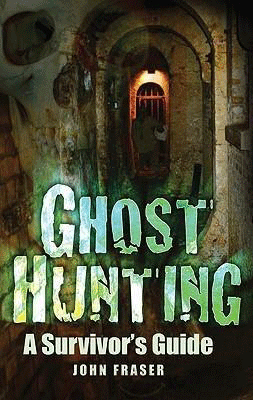 Ghost Hunting, A Survivors Guide
Ghost Hunting, A Survivors Guide
By John Fraser
Published by The History Press, 2010.
Before I start this piece, I feel I should ‘fess up’ and admit that the author is a friend of mine. John Fraser is one of the longest standing Ghost Club members within the current membership. He was also once Vice Chairman of the club, serving for several years on its Council.
When Ghost Hunting, A Survivors Guide was offered to The Ghost Club for review, I promised John that even though we were friends, my review of his book would be a fair account, completely honest and that I would show no favour. Of course, he agreed entirely, although he made sure that I could spell ‘outstanding’ and ‘remarkable’ beforehand!
To the review, then. On first impressions, the book is presented well. Hard backed with suitably eerie dust cover illustrations and photography showing the gloomy corridors of the Clerkenwell House of Detention, finished off with the shade of a spooky skull, there should be no confusion as to the subject matter covered within its pages.
Inside, the book is equally well presented with a tidy, uncomplicated layout. I particularly liked the use of miniature skulls in place of bullet points! It is a very readable book and flows with a steady stream of relevant and interesting information regarding all aspects of paranormal investigation. Split into ten chapters, covering everything a ghost hunter needs to know, whether they are just dabbling or are a seasoned ghost hunter. The book covers in depth, the history of ghost hunting; modern ghost hunting; the use of equipment on investigations, scientific and non, how it should be used and whether or not it is needed; academic parapsychology and how the subject is slowly becoming accepted by mainstream science. There is also a very good section on organising paranormal investigations with lots of tips and a checklist, which I shall certainly be referencing the next time I have to organise an investigation for the Ghost Club. Following this, there is a great chapter on analysing and making sense of your findings.
The centre of the book is fashioned with a small selection of black and white photographs with captions of places, phenomena and other subjects mentioned throughout the book and there is a useful list of respected paranormal organisations and their contact details at the back of the book.
To conclude then, Ghost Hunting, A Survivors Guide is a beautifully presented, extremely well written source of reference for anyone interested in participating in or organising a paranormal investigation. The only downside for me personally, and it is only very insignificant gripe on my part, is that the photographs aren’t distributed throughout the book, rather than being in a block in the centre. It gives it a slightly more dated or old fashioned feel. Apart from that, I would not hesitate to recommend this book – in fact, I would go one step further and suggest it as required reading to anyone prior to attending or organising an investigation. So I have to say, I agree with the author. This book IS Outstanding and Remarkable and would make a welcome addition to any investigators book shelf.


